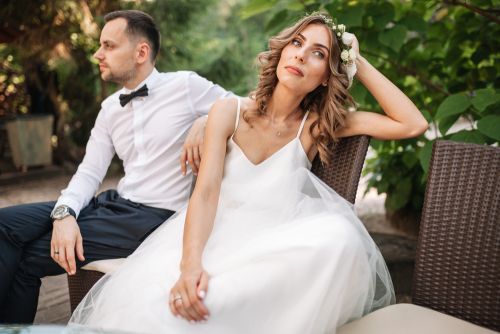 Whether you’re fanatical about the fine details or a little more laid-back, you know that your wedding day is a big deal. You don’t have to be a typical engaged couple or go all in on a fancy event. But even then, each partner can end up with different ideas about the big day. What can you do when those plans aren’t compatible? This useful guide can help you merge your visions together to create an event you’ll both enjoy.
Whether you’re fanatical about the fine details or a little more laid-back, you know that your wedding day is a big deal. You don’t have to be a typical engaged couple or go all in on a fancy event. But even then, each partner can end up with different ideas about the big day. What can you do when those plans aren’t compatible? This useful guide can help you merge your visions together to create an event you’ll both enjoy.
The Big Stuff
Before you look at flowers, attire, or food, there are four basic things you must decide first: date, venue, guest count, and budget. And of these four, your budget is the most critical. It determines where you can host your event, how many can attend, and when it’s feasible to even tie the knot. Disagreements at this stage are more common than you may think, but you’ll need to work through them to do any major planning.
Communication is important at any planning stage, but it’s especially vital in the beginning. That’s why expert Jacqueline Tynes, in a January 2018 Wedding Wire piece, suggests that each partner should make a “must-haves” list. You can look at and discuss your lists to see what they have in common. Those intersection points can provide some guidance as you make the major wedding day decisions.
How To Compromise
In a November 2020 Brides article, Jaimie Mackey mentions that compromise is key when both partners can’t agree on details. Perhaps you picture a beachside celebration, for instance, but your partner prefers the great indoors. If natural beauty is one of your “must-haves,” why not choose a botanical garden? You’ll have access to both inside and outside spaces, plus you can still host a casual affair.
Sometimes, finding a point of compromise isn’t easy. That’s why Mackey suggests keeping wedding details in proper perspective. After all, you have two top priorities: tying the knot legally and providing a memorable experience for yourselves plus your family and friends. Flowers, décor, and other less crucial specifics dwarf in comparison. Maybe that means you ditch the orchids you want and pick a less expensive flower to free up money in your budget. That money helps pay for one of your partner’s must-haves – a larger dinner spread, for instance.
Beyond the Details
Weddings are emotional events. Our deep-seated desires are tied to these emotions. If you and your partner can’t seem to compromise during the planning stage, it’s time to look at the bigger picture. You both need to ask yourselves what you really want from your wedding and why.
When taking a second look at your wedding plans, The Knot suggests looking for “hidden issues.” These could be driving your desires or anxieties about the big day. Are you trying to make your event conform to a “perfect wedding” ideal? Do you worry about impressing your family and friends? Is there pressure from family members to invite more people or include certain traditions? An open and honest discussion can get these concerns out in the open. Only then can you work together on solutions for dealing with them.
Remembering What’s Important
At the end of the day, your goal is to marry the person you love. And unless you’d rather take a road trip and elope, you probably want your friends and family to celebrate with you. Since your wedding will reflect both of your personalities and values, collaboration during the planning stage is vital. When you have difficulty creating a unified vision for your event, three keys can help you work things out: communication, compromise, and keeping sight of your priorities.